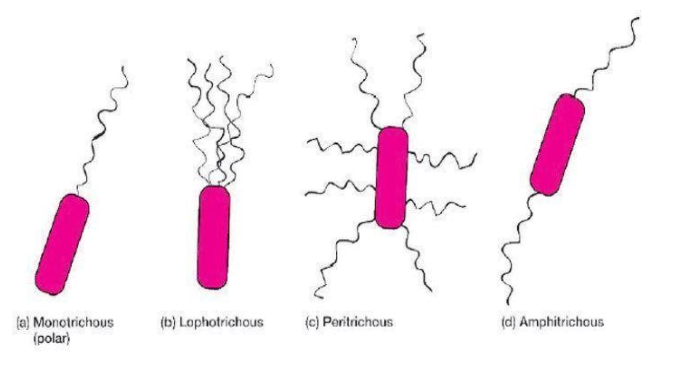
What are lateral appendages? Based on their presence and absence write the various types of flagella giving at least one example of each type?
Answer
492k+ views
Hint: Appendages are additional or outgrowth of a body part.
In bacteria the example of lateral appendage is flagella.
Flagella help in movement of bacteria from one place to another (locomotion).
We are not able to see them under the light microscope because they are too small in size.
Complete answer: In order to solve this question we need to know about the lateral appendages.
Appendages are an extra growth of any body part (such as in extremities) which can also be a natural protuberated part.
It is mainly found on the sides.
Lateral appendage generally means limbs on the sides.
Appendages include parts of mouth, parts of tail, gills in many animals, legs which can be for walking, climbing etc.
Appendages help in movement from one place to another, feeding and grooming.
In bacteria’s flagella is one the example of lateral appendages.
Flagella are a long locomotory structure present in many single cell organisms which help them in locomotion.
In some eukaryotic cells flagella is covered by the cell membrane.
In eukaryotes flagella moves in “s” shaped motion.
But we are not able to see the flagella on a microscope.
There are mainly four types of flagella.
1. Monotrichous: It means having one flagellum.
For example: vibrio cholera
2. Amphitrichous: It means single flagellum on both sides.
For example: Alkalinegens faecalis.
3. Lophotrichous: Tufts of flagella at one or both sides.
For example: spirillum
4. Peritrichous: they have flagella spread across the body except the poles.
For example: E.coli.
Look at the following diagram for better understanding.

Note: Cilia: It is a tiny, hair-like projection found on the cell surface of various mammals.
It can be single or present in groups.
Pseudopodia: It is cytoplasmic outgrowth seen in amoeba.
Pseudopodia also helps in locomotion in amoeba.
Due to the presence of pseudopodia in amoeba it helps in altering the shape of amoeba.
So, that’s why species of amoeba are known as proteus.
In bacteria the example of lateral appendage is flagella.
Flagella help in movement of bacteria from one place to another (locomotion).
We are not able to see them under the light microscope because they are too small in size.
Complete answer: In order to solve this question we need to know about the lateral appendages.
Appendages are an extra growth of any body part (such as in extremities) which can also be a natural protuberated part.
It is mainly found on the sides.
Lateral appendage generally means limbs on the sides.
Appendages include parts of mouth, parts of tail, gills in many animals, legs which can be for walking, climbing etc.
Appendages help in movement from one place to another, feeding and grooming.
In bacteria’s flagella is one the example of lateral appendages.
Flagella are a long locomotory structure present in many single cell organisms which help them in locomotion.
In some eukaryotic cells flagella is covered by the cell membrane.
In eukaryotes flagella moves in “s” shaped motion.
But we are not able to see the flagella on a microscope.
There are mainly four types of flagella.
1. Monotrichous: It means having one flagellum.
For example: vibrio cholera
2. Amphitrichous: It means single flagellum on both sides.
For example: Alkalinegens faecalis.
3. Lophotrichous: Tufts of flagella at one or both sides.
For example: spirillum
4. Peritrichous: they have flagella spread across the body except the poles.
For example: E.coli.
Look at the following diagram for better understanding.

Note: Cilia: It is a tiny, hair-like projection found on the cell surface of various mammals.
It can be single or present in groups.
Pseudopodia: It is cytoplasmic outgrowth seen in amoeba.
Pseudopodia also helps in locomotion in amoeba.
Due to the presence of pseudopodia in amoeba it helps in altering the shape of amoeba.
So, that’s why species of amoeba are known as proteus.
Recently Updated Pages
The correct geometry and hybridization for XeF4 are class 11 chemistry CBSE

Water softening by Clarks process uses ACalcium bicarbonate class 11 chemistry CBSE

With reference to graphite and diamond which of the class 11 chemistry CBSE

A certain household has consumed 250 units of energy class 11 physics CBSE

The lightest metal known is A beryllium B lithium C class 11 chemistry CBSE

What is the formula mass of the iodine molecule class 11 chemistry CBSE

Trending doubts
State the laws of reflection of light

One Metric ton is equal to kg A 10000 B 1000 C 100 class 11 physics CBSE

Difference Between Prokaryotic Cells and Eukaryotic Cells

How do I convert ms to kmh Give an example class 11 physics CBSE

Describe the effects of the Second World War class 11 social science CBSE

Which of the following methods is suitable for preventing class 11 chemistry CBSE




